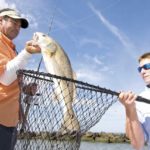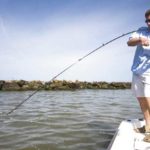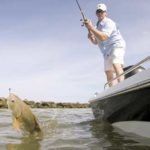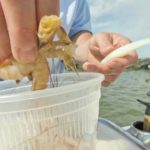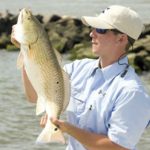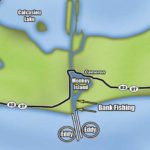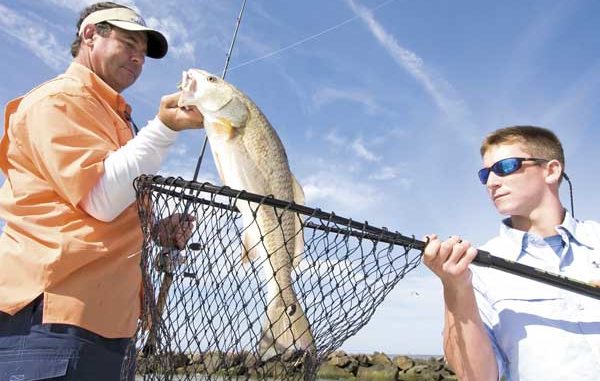
Anglers burn with passion over the seasonal movement of redfish to the jetties south of Calcasieu Lake.
We weren’t expecting what greeted us as we approached the ends of the Ship Channel rock jetties below Lake Charles.Matt Solari, a veteran Calcasieu Lake angler from Jennings, got an uneasy feeling in his stomach, and the corners of his mouth began to recede.
Not even 12 hours had passed since he told me over a platter of boiled crawfish that he and his son Chris had really worked over the big redfish on the rocks earlier that day.
“Man, it was great,” he said after washing down a mouthful of meat. “The water was dead calm. We haven’t had that on Calcasieu for several weeks — no problem catching as many as you want tomorrow.”
Now that tomorrow was today, Solari was probably wishing he had spent more time elbow deep in crawfish and a cooler of beer than preparing for our trip and going to bed. As it appeared, this trip didn’t look like it was going to be much fun. The 5-foot rollers hammering the ends of the rocks were going to make sure of that.
Chris Solari shared what he thought was a secret glance with his dad that said in no uncertain terms, “We’re screwed.”
It was apparently Chris Solari’s job to jump to the front of his dad’s new 21-foot NauticStar bay boat to drop the anchor. The way the waves were tossing us around, I completely understood his icy stare.
“So much for smooth water,” Matt Solari hollered over the roar of the surf. “Let’s try to get around to the west side of this west jetty and see if we can set up in the eddy.”
If his confidence was shattered, he was doing a good job hiding it. As we tossed around like a bottle in the sea, Matt Solari explained why we had such big waves even though the wind was fairly calm.
“We’ve got an outgoing tide right now,” he said. “And the wind we do have is blowing right up between the jetties. Talk about your irresistible force meeting an immovable object. Both the wind and the tide are running up against a brick wall. The wind’s trying to blow water in, and the tide is trying to push it out.”
As Matt Solari got his boat positioned on the west side of the west jetty, Chris Solari and I held on to anything that felt secure enough to support us, and we began heaving soft plastics tipped with shrimp toward the rocks. The rollers were too much for us to contend with, though, so Matt Solari ordered all lines in after just a few minutes of fruitless casting.
He fought his way back to the east side of the west jetty. The water was a little calmer between the jetties, and it was a little clearer. Nothing really looked bad about the situation inside the jetties, but this wasn’t where Matt and Chris Solari had caught their reds the day before, so they were just a little unsure.
“We’ll just have to find some more,” said Chris Solari as we idled past a boat that was already anchored beside the rocks. The four young anglers inside were whooping and hollering as all four of their rods were bowing deeply under the strain of big things below the surface.
“If we get these in, we’ll have our limits and y’all can have this spot,” one of them let us know. “We’ve only been here about 20 minutes, and it’s been on ever since we pulled up.”
While we poked around and waited for our turn at the honey hole, Matt Solari told me a little more about what we were doing. He has fished the rocks at the southern end of the Calcasieu Ship Channel since he was 13 years old.
In that time he’s learned that when the reds decide it’s time to move from the Gulf of Mexico into Calcasieu Lake, they don’t have any choice but to swim between the two sets of jetties. And when they do, there’s no place he would rather be than between these two long lines of rocks.
The redfish tend to start moving through the ship channel on their way to the big lake sometime in late April or early May. Matt Solari believes they follow the finger mullet in from their spawn because reds never want to be too far away from such an ample food source.
“As the reds move in, the jetties create a bottleneck that congregates them into a very confined space, as far as saltwater fishing goes. Once word gets out that there here, there will be a lot more boats than what you see here today,” Matt Solari said while sweeping his hand across the two or three nearby boats. “The pressure will grow as we move into the summer. June is when we probably see the most pressure because that can be some of the best fishing.”
The four guys eventually won their battles, and they happily reined in the anchor. We jumped the claim, and tossed out our anchor. Before his bait could even hit bottom, Matt Solari was already loaded up with a fish. It didn’t take long for the line on his trout rod to snap to make us 0 for 1.
“I knew I should have changed rods,” he said sheepishly. “I wouldn’t recommend anything under 20-pound-test down here on the rocks. I know some people who come down here with light offshore tackle and 30-pound-test line or more. That’s a little overkill for me. I like the challenge of the lighter line and a 7-foot heavy-action rod. Anything more than that, and it’s like jerking them in rather than fishing.”
While Matt Solari respooled his reel with 20-pound line, Chris Solari and I started throwing natural-colored Berkley Gulp! Shrimp that were threaded onto 1/4-ounce jigheads. As if the Gulp! scent wasn’t enough, we tipped our rigs with pieces of market shrimp. The unbroken chain of reds began almost immediately.
The scene grew even more chaotic as Matt Solari got back in the water. Doubles and triples were common as we struggled to figure out which fish we were fighting and who had time to grab the net. We were about a half-cast away from the rocks, and we had the fish pegged, but Chris Solari said it isn’t always this easy.
“I think we could go anywhere on these rocks today and catch fish,” he said. “When my friends call me to find out how to catch these reds, I always tell them to start out by getting about a cast length from the rocks and keeping their trolling motor in the water until they get a bite. Once they get bit, I tell them to stick around to see if they catch another. If they catch two in the same spot, I tell them to drop the anchor and stay a while.”
As our Gulp! shrimp ran dry, we started picking up other plastics like Norton Sand Eels and H&H Cocahoes — still tipping each with shrimp. There was a lull in the action after the switch to the other plastics, but it didn’t take long for the reds to home back in on our lures.
The key to catching the reds on the rocks is smell. Our Gulp! and shrimp gave the reds a double dose of it, and now that we were restricted to regular plastic and shrimp, it was like the smell was cut in half. In the end, it didn’t matter what plastic we threw, but for about 30 minutes after we ran out of our scented baits, it did.
“You can catch reds out here on artificials like Rat-L-Traps,” said Matt Solari, “but you really need something dead or live and smelly. Market shrimp is quick and easy for tipping a jig, but I know some anglers who prefer cracked crab or even live mullet on a Carolina rig. I don’t think it really matters as long as you have something that smells like food sitting down there on bottom when they pass by.”
As we continued reeling in red after red, we noticed that all our fish were just about the same size. There were a few “grillers” in the mix, but many were 25 to 28 inches long. I wondered if it was common for redfish to run in the same-sized packs on the jetties.
“The upper end of what we’re catching today is 30 inches,” said Chris Solari. “These 27- to 30-inch fish get pretty common at times. Sometimes we’ll get sloughs of 20-inchers, but for the most part if you’re catching them like this then you’ll catch all different sizes under 30 inches. The bulls are a different story, though.”
Bull reds in the 20-pound range and heavier tend to run in the same-sized packs. They are also most frequently found out on the ends of the jetties, and if you catch one 20-pounder out there, you can bet that everything else you catch will be around the same size.
When he wants to target the bull reds, Matt Solari goes out to the ends of the rocks and positions his boat on the outside of either point. He first tries throwing right up to the edges of the rocks on the points, but if that doesn’t work, he backs off to the edges of the eddies behind each point and casts into the calm water.
“A lot of people go with the Carolina rig out on the ends of the jetties,” he said. “All it takes it a kahle hook, a swivel and an egg sinker to get your bait to the bottom. This is also where the crabs and live mullet come more into play. Cut bait works well too. I sometimes get a big mullet and cut it into three chunks. All these smelly baits just sitting on the bottom out there in that eddy are just too much for those big reds to stand.”
While Matt Solari believes that the best fishing is out on the jetties where they break away from the land, the rocks still continue up the channel and line the banks for a pretty long way.
The ends may be better because that’s where the fish will first congregate, but they still have to move up the channel. Bank-bound anglers sitting on the rocks often catch their fair share of reds, although they do tend to catch a wider variety of fish from the shore.
Since bank-bound anglers are confined to a relatively small location, it becomes that much more important to attract passing reds with the power of scent. The basics of it are that if you have a bait in the water that smells like food when a big red passes, you can catch fish by sitting on the rocks.
As our final few fish were added to the cooler, Matt Solari concluded that an angler could catch reds just about anywhere up and down the rocks that they wanted to fish right now. Every boat we saw during the day — and the number of boats grew as the day went on — was catching redfish. But just as our day couldn’t last forever, the redfish action on the rocks can’t last forever.
“They’ll eventually slow down and move back off the rocks when it gets too hot during July and August,” he said as we idled back into the canal at Hebert’s Landing. “You can still catch reds down there in the hot part of summer, but they get spotty. They also tend to get off the rocks and get on the flats outside each of the jetties. As they do that, the folks fishing the beaches begin to have their fun.”
I’ve been with too many anglers who get aggravated when the big redfish just won’t stop biting. Whether they just get tired of reeling them in or they prefer the trout bite, they don’t mind showing their butts when the big reds turn on, and they get that look in their eye and make a big stink about all those danged reds.
Matt Solari had that same look in his eye early on during our trip, but his look of disdain wasn’t because he was catching too many. It was because he didn’t think we would be able to catch any.
Turns out he was wrong because the reds were on the rocks. And as long as the ship channel is their only way in and out of Calcasieu Lake, they always will be.
